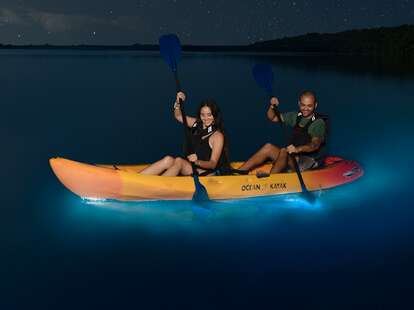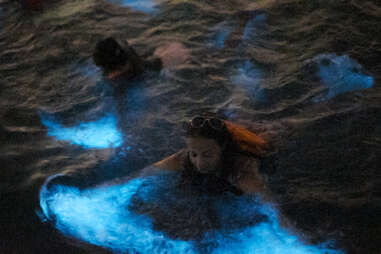
You Can Actually Go Swimming in This Rare Glowing Bay
There are only a couple places in the world you can… get lit.
The water is jet-black, but under the surface, there’s evidence of magic. Run your fingers through it and it comes alive, shimmering like blue-green stars. Lift your hand up and it glitters: They say humans are made of stardust and here it could be true. Above, the moon hides behind clouds, but it’s better this way: a bright beam from above would only ruin the luminous effect.
This is what it’s like to glide through a bioluminescent bay: rare ecosystems that occur when microscopic organisms called dinoflagellates converge in the thousands per gallon. When agitated they glow in the dark, turning a tropical night into something out of a science fiction movie.
They say humans are made of stardust and here it could be true.
These sparkling ecosystems only occur in a handful of sites around the world, usually in warm water with narrow access to the open seas. One is the famous emerald waters of Ha Long Bay in Vietnam, designated a UNESCO World heritage site in 1994. Another is Luminous Lagoon, in the marshlands of Jamaica.
And there are three—count ‘em, three!—bioluminescent bays located in Puerto Rico. Which means that with a mere 2.5-hour flight from Miami you can experience this natural nighttime phenomenon in person.

Where to find bioluminescent bays in Puerto Rico
The first of the three bioluminescent bays is Mosquito Bay located on Vieques, a tiny island seven miles off the southeast coast of the main island. This is the most sought-after bioluminescent bay experience as it’s traditionally the brightest of the bunch (declared so by the Guinness Book of World Records in 2006). Visiting the waters of Vieques usually requires an overnight stay, as the ferry stops running early evenings.
Near the town of Fajardo on the northeast tip of the main island, a visit to Laguna Grande lets you traverse through mangroves, partially protected by the Cabezas de San Juan reserve’s coral reef. And finally, there’s La Parguera in the southwestern town of Lajas, a little over a two-hour drive from San Juan. The region has yet to be tapped by the tourism throngs, which means its quiet natural wonders and abundant wildlife are largely undisturbed.
And then there's La Parguera: the only bioluminescent bay where it’s legal to swim in the country (but not the world; apparently you can jump right on into Jamaica’s lagoon).
Why can you swim here and not the others? “La Parguera is the most open to the ocean,” says Percy Rier of Kayaking Puerto Rico, which guides tours out to the Laguna Grande Bio Bay. “Therefore it has a more complete exchange of water.” That helps keep this shallow bay clean by flushing out harmful chemicals like insect repellent, sunblock, perfumes, and oils. It also filters out the sediment kicked up by hundreds of nightly guests, which would otherwise affect the microorganisms’ glow power.
Dinoflagellates need clear waters to do their thing. “Because of the slower exchange of water in Vieques and Laguna Grande,” Percy explains, “the sedimentation will stay in the same place for longer periods of time.” Which is why tourist activity in Mosquito Bay and Laguna Grande is limited to boat or kayak excursions, including clear-bottomed options.
Dinoflagellate count is fragile: In all three of Puerto Rico’s bays, it dipped dramatically after Hurricane Maria in late 2017. Laguna Grande is still lagging in numbers but Mosquito Bay and La Parguera have fully recovered, with locals reporting the bays even brighter than before.
What to know before swimming in La Parguera
A number of local tour groups like Rincon Vacations and Alelí Tours will take you out to kayak, swim, or even snorkel in the bay, or you can rent your own kayak and go at it solo. Before you go, skip the sunscreen, lotion, perfume, and anything else chemically that could harm the dinoflagellate ecosystem. If you use bug spray, opt for DEET-free.
The timing of your tour is also crucial: You want it as dark as possible. Try to snag the latest available time slot, and avoid visiting during a full or near-full moon (they recommend the New Moon phase).
Overcome the mental hurdle of jumping into opaque black water, and dive in. Splash as much as possible to activate the enchanting blue-green sparks. Most importantly, take mental pictures—after tonight, this bucket list experience only resides in your memory. Bioluminescent bays are very much unphotographable—most of the photos you see online are photoshopped.

What to do near La Parguera
The bay is enchanting for sure, but there’s more to see in this Southwest region. Far away from the resorts and touristy San Juan, here you can get a taste of what living on the island is really like.
So make a trip of it: Miles of coastline offer gorgeous secluded beaches, while the pink salt flats of the Cabo Rojo wildlife refuge are not only visually stunning, but an important stop over for migratory birds in the Eastern Caribbean. The town of La Parguera is a fishing village turned nightlife destination, with a waterfront boardwalk lined with food, games, tropical cocktails, local artisans, and a much-used outdoor stage. And caffeine fiends can explore the thriving coffee industry of Yauco, known as El Pueblo del Café (Coffee Town), as well as a really cool mural project Yaucromatic that celebrates the community and Puerto Rican history.